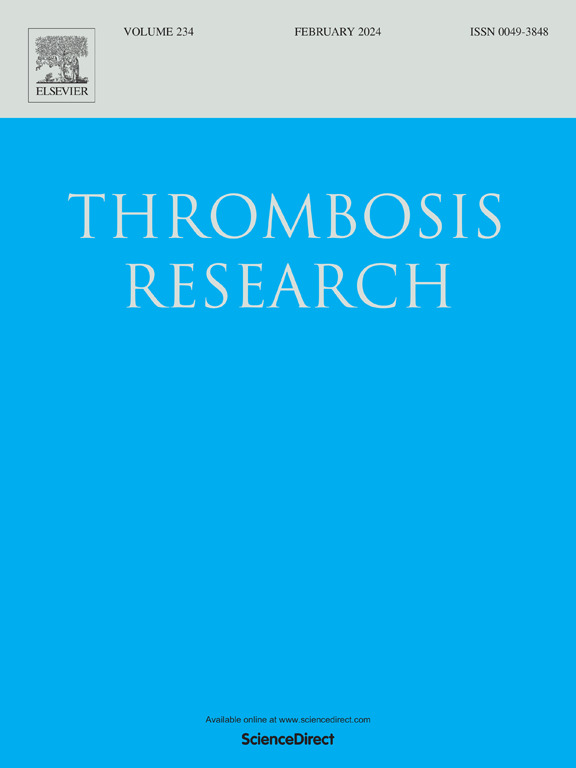Inhibiting mTORC1 pathway by rapamycin restores the balance of CD8+ T cell subsets and reduces CD8+ T cell-mediated platelet destruction in immune thrombocytopenia
IF 3.4
3区 医学
Q1 HEMATOLOGY
引用次数: 0
Abstract
Background
CD8+ T cells contribute to platelet destruction in immune thrombocytopenia (ITP). Rapamycin, a mechanistic target of rapamycin complex 1 (mTORC1) inhibitor, has demonstrated efficacy in relapsed/refractory ITP. However, its impact on CD8+ T cells in ITP remains unexplored.
Methods
Gene expression profiles from GSE43177 dataset were analyzed using gene set enrichment analysis (GSEA). Activation of the mTORC1 pathway and CD8+ T cell subsets was evaluated using flow cytometry. CD8+ T cell cytotoxicity was assessed by measuring perforin, granzyme B expression and platelet apoptosis. Additionally, an active ITP murine model was established for validation.
Results
GSEA of the GSE43177 dataset revealed significant enrichment of mTOR pathway in ITP patients with high CD8+ T cell abundance. CD8+ T cells from peripheral blood of ITP patients exhibited enhanced mTORC1 pathway activation, as evidenced by elevated phosphorylation levels of mTOR, p70S6K, and 4EBP1. Additionally, CD8+ T cell subsets were imbalanced in ITP patients, with reduced naïve T cells, increased effector memory T cells, and decreased CD28− T cells, alongside elevated cytotoxicity. In vitro treatment with rapamycin restored the homeostasis of CD8+ T cell subsets and reduced CD8+ T cell-mediated platelet apoptosis. Furthermore, rapamycin effectively ameliorated thrombocytopenia and modulated CD8+ T cell subsets in the active ITP murine model.
Conclusion
Our findings demonstrate that inhibition of mTORC1 by rapamycin restores the homeostasis of CD8+ T cell subsets and reduces CD8+ T cell-mediated platelet destruction in ITP. These results provide a mechanistic rationale for the clinical application of rapamycin in ITP management.
通过雷帕霉素抑制mTORC1通路恢复CD8+ T细胞亚群的平衡,并减少CD8+ T细胞介导的免疫性血小板减少症血小板破坏
背景cd8 + T细胞参与免疫性血小板减少症(ITP)的血小板破坏。雷帕霉素是雷帕霉素复合物1 (mTORC1)抑制剂的机制靶点,已证明对复发/难治性ITP有效。然而,其对ITP中CD8+ T细胞的影响尚不清楚。方法采用基因集富集分析(GSEA)对GSE43177数据集的基因表达谱进行分析。使用流式细胞术评估mTORC1通路和CD8+ T细胞亚群的激活情况。通过检测穿孔素、颗粒酶B表达和血小板凋亡来评估CD8+ T细胞毒性。此外,还建立了一种活性ITP小鼠模型进行验证。结果GSE43177数据集的gsea显示,CD8+ T细胞丰度高的ITP患者中mTOR通路显著富集。ITP患者外周血CD8+ T细胞mTORC1通路激活增强,mTOR、p70S6K和4EBP1磷酸化水平升高。此外,ITP患者的CD8+ T细胞亚群不平衡,naïve T细胞减少,效应记忆T细胞增加,CD28−T细胞减少,同时细胞毒性升高。体外雷帕霉素治疗恢复了CD8+ T细胞亚群的稳态,减少了CD8+ T细胞介导的血小板凋亡。此外,雷帕霉素有效地改善了血小板减少症,并调节了活性ITP小鼠模型中的CD8+ T细胞亚群。结论雷帕霉素抑制mTORC1可恢复ITP中CD8+ T细胞亚群的稳态,减少CD8+ T细胞介导的血小板破坏。这些结果为雷帕霉素在ITP治疗中的临床应用提供了机制依据。
本文章由计算机程序翻译,如有差异,请以英文原文为准。
求助全文
约1分钟内获得全文
求助全文
来源期刊

Thrombosis research
医学-外周血管病
CiteScore
14.60
自引率
4.00%
发文量
364
审稿时长
31 days
期刊介绍:
Thrombosis Research is an international journal dedicated to the swift dissemination of new information on thrombosis, hemostasis, and vascular biology, aimed at advancing both science and clinical care. The journal publishes peer-reviewed original research, reviews, editorials, opinions, and critiques, covering both basic and clinical studies. Priority is given to research that promises novel approaches in the diagnosis, therapy, prognosis, and prevention of thrombotic and hemorrhagic diseases.
 求助内容:
求助内容: 应助结果提醒方式:
应助结果提醒方式:


